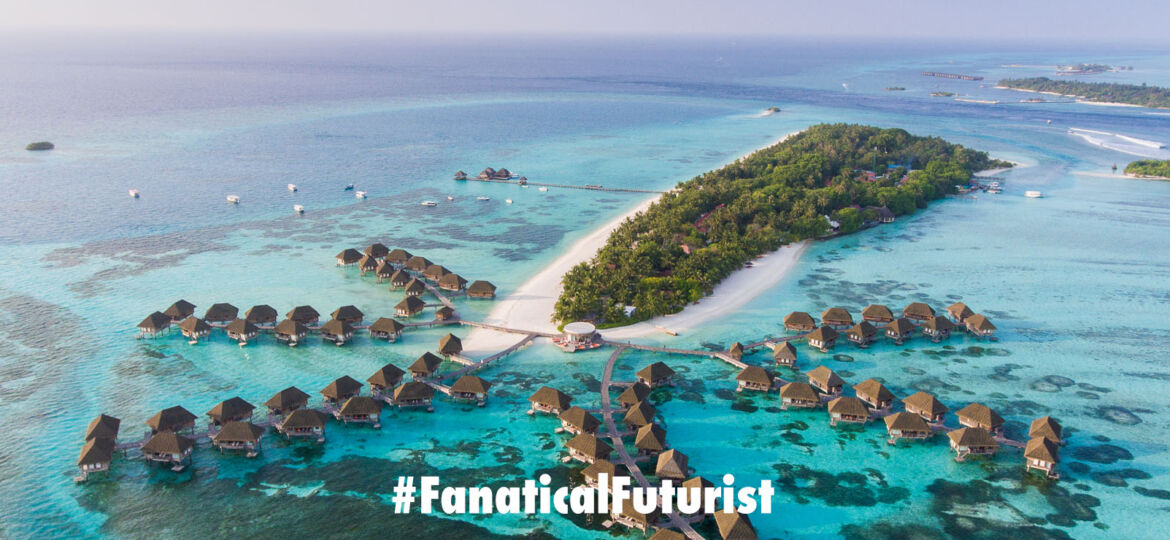
WHY THIS MATTERS IN BRIEF
Climate change and rising sea levels will displace billions of people, and the Maldives government is preparing itself …
 Love the Exponential Future? Join our XPotential Community, future proof yourself with courses from XPotential University, connect, watch a keynote, or browse my blog.
Love the Exponential Future? Join our XPotential Community, future proof yourself with courses from XPotential University, connect, watch a keynote, or browse my blog.
As sea levels rise thanks to climate change some of the world’s lowest lying countries are seeing their coastlines vanish underwater, and in the Maldives case their government have been buying tracts of land near Mongolia for the past decade so they can re-home their population, who would also become the first mass climate refugees, if the islands do eventually vanish. In recognition of the growing crisis the United Nations recently approved Oceanix, the world’s first ocean city concept, and a developer in the USA started selling ocean condos for up to $1 Billion a pop – at sea.
Now government officials in the island nation of the Maldives have officially unveiled plans to build the first fully floating island city of its kind. Could the ambitious experiment be a blueprint for how we’ll live in the future as climate change continues to raise the global sea level?
Introducing the MFC
As “arguably the lowest-lying country in the world,” according to NASA – the average elevation is just 3.3 feet above sea level – the Maldives, an island republic in the northern Indian Ocean, will soon have to rely on sustainable housing. In virtually any simulation of the near future, the over 1,000 individual islands that make up the Maldives will be some of the first to disappear below the rising sea level.
Enter the floating city, appropriately called Maldives Floating City (MFC), which will be built in a lagoon just minutes from Male, the capital of the Maldives. MFC’s designers, the Netherlands-based Dutch Docklands, the “global leader in floating infrastructure,” say the floating city’s shape, a series of honeycomb-like hexagonal maze rows, is supposed to resemble coral.
The system of floating rows is anchored to a ring of islands that form the base and also the stabilizing breaker wall for all the structures – the primary reason for placing MFC in an ideally suited small lagoon. More from the press release:
“While MFC floats up top, island barriers around the lagoon will serve as breakers down below. This ingenious configuration lessens the impact of lagoon waves while stabilizing the structures and complexes on the surface.”
The whole city is about three-quarters of a square mile, or 200 hectares, with low-slung residential buildings and commercial amenities built on separate structures. The designers say the MFC complex hearkens back to the history of seafaring culture and local architecture in the Maldives.
Thousands of homes will float on the hexagonal coral clusters, starting at $250,000 for about 1,000 square feet, plus a roof terrace. While that price point isn’t laughably low, it’s perfectly reasonable for the context of an island vacation wonderland.
If the idea of a modular floating city makes you think of, say, Waterworld, you’re not alone. There are also traditional floating cities scattered around the world, and the Maldiveans are careful to say theirs is the first to combine the housing and other structures in this particular way, surrounded by a barrier lagoon and with an array of amenities.
The floating city will break, uh, sea in 2022. Eventually, the complex will include those thousands of homes, plenty of commercial space for stores and necessaries, and a hospital and school for locals to use. While the complex is anchored to the barrier islands, this will likely be a modular connection that can be extended as the sea level rises—perhaps even submerging the barrier islands in the future.
If MFC succeeds, the officials are likely right that it will be influential around the world. While inland territories have a lot more time to avoid the most literal effects of the rising sea level, the Maldives’ peer island nations like Nauru or Micronesia will have to act quickly to preserve their territories and cultures.
















